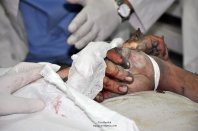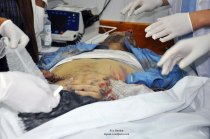 *Nader Abu Mghaseeb, 14, killed by targeted Israeli drone bombing two hours before the “cease-fire” while going to get food for his family.
*Nader Abu Mghaseeb, 14, killed by targeted Israeli drone bombing two hours before the “cease-fire” while going to get food for his family.**NOTE: contains graphic images…reality of Palestinians under occupation and continuous Israeli attacks.
Nov 21, al Aqsa hospital, Deir al Balah. At approximately 2pm, Mubarak Ibrahim Abu Houly, 24, was walking among the olive trees on his land when the drone hit him, tore off his left leg… not that it mattered…he was instantly dead. Drone strikes come without any warning. The sky is continually filled with the buzzing of the drones, and eventually you tune them out, they become background noise. Abu Houly lived in central Gaza’s Nusseirat camp, an area that has been hammered by Zionist bombings this past week.
In Deir al Balah’s al Aqsa hospital morgue—a small room with two three-drawer fridges—Mubarak’s body, awaiting burial, is another testament to the Israeli drone strikes occurring throughout the Strip. Yes, they are precision, but no, they are not merely targeting Israel’s wish list, they are targeting anyone, anywhere. A branch of the olive tree he was killed near lies above his head on the morgue slab, his face marked by shrapnel but intact, likewise his torso. It is at his hipbone when the shredded, burnt flesh appears, the only evidence of where a leg was.



 The staff at Aqsa hospital say, as do news reports from around Gaza, that a high percentage of the martyred were on their land, in or outside their homes, civilians in residential areas. Two days earlier, three men in their twenties, two from the Abu Bashir family in Deir al Balah, had just harvested tomatoes from their greenhouse, loaded the flatbed truck, and begun returning to the town when they were targeted by an Israeli warplane.
The staff at Aqsa hospital say, as do news reports from around Gaza, that a high percentage of the martyred were on their land, in or outside their homes, civilians in residential areas. Two days earlier, three men in their twenties, two from the Abu Bashir family in Deir al Balah, had just harvested tomatoes from their greenhouse, loaded the flatbed truck, and begun returning to the town when they were targeted by an Israeli warplane.
4:26 pm: an ambulance rushes into the hospital’s small parking lot, medics jumping out to rush a tiny body into emergency. The girl, 4, dies on the emergency table as doctors try in vain to revive her.
Reham Maher Nabaheen died at 4:27 from the shrapnel lodged in her head after an Israeli army strike targeted outside her family home in Nusseirat. Her father, in the simple, ragged clothes of Gaza’s poorest, moves between Reham’s bed and that of his wife, injured in the strike, sobbing uncontrollably.
The next martyr is rushed in shortly after the morgue fridge door closes on Reham, wrapped in her white, blood-stained, bed-sheet shroud. Rami Abeid, 37, is the first of five martyrs to be brought into Aqsa hospital after the Israeli F-16ing of the Abu Kmeil house in al Mughraqa, Nusseirat. His body, covered with the dust of rubble, is in one piece.
But his face is crushed, bloated. The crushing of his head leaves a thick blood-stain on the stretcher he was carried in on, under which is the debris from the rubble he was trapped under. Quickly enough, he is packaged in the standard white bed-sheet shroud and wheeled into the tight morgue for storage.
The next martyr brought in, wrapped, and stored likewise leaves behind a blood-stain in the form of a head on the metal gurney. One of the civil defense rescuers who helped bring 35 year old Mohammed Abu Eteiwy to the hospital is wracked with sobs: Abu Eteiwy was a rescuer colleague, off-duty and visiting the Abu Kmeils when their home was bombed.
It’s now 6:15 and dark out. The drones continue their ominous humming, the scene is almost out of some horrible futuristic, end-of-the-world movie…and it feels as much. The medics tell us after delivering Abu Eteiwy that they are still searching for the other martyrs. One is half-visible, the others completely buried.
Palestinian medics are among the bravest people alive. They continually face the Zionist tactics of double or triple bombing a targeted site. The medics in their quest for survivors and the martyred go head first into such sites. Some pay the price dearly.
In the 2008-2009 Israeli attacks on Gaza, 16 medics were killed in Israeli army attacks while aiding Palestinian injured or bringing in the martyred. The good-natured cameraman who yesterday sobbed at the loss of his journalist colleague—Mohammed Bader, killed while going to document the recently-bombed Abu Tama’a home in Deir—is today stoically back at work, determined to document everything. “I’ve been here everyday since these attacks began,” he tells us. “I sleep at the hospital, 2 or 3 hours, then get back to work.” At 6:25, an ambulance delivers the body of Sady Abu Kmeil, 26, whose concrete-dusty corpse resembles that of the two men before him.
Across from the empty emergency room bed where Sady Abu Kmeil’s body no longer is, a woman lies on a hospital bed, arms in the air shaking uncontrollably.
“Psychotic trauma,” one of the doctors tells me. “She is the sister of Mohammed Abu Eteiwy.” When I ask if he sees many cases of psychotic trauma, he answers without pause, “oh, yes!” The brother of Rami Abeid, the first martyr brought in, is at the hospital, tells us his dead brother and friends were just sitting in the house when the Israeli army bombed it.
The next body, that of Nidal Hassan, 32, is brought in and out, same routine to the morgue. The Civil Defence ambulance which just delivered him backs up in the small parking lot before turning around to go off for more victims. It’s backing alert is, instead of a beep, incongruously a cheerful children’s song. In the dark, drones droning, the night gets more surreal.
7:07 pm, waiting for the last of the Abu Kmeil home martyrs. Another Israeli-dropped bomb blasts out over the drones’ buzz. Six minutes later the last martyr, Ahmed Abu Kmeil, 23, is brought in, wrapped, stored. His body is intact, but his face and ears have melted from the bombing. An older woman sitting comatosely quiet is, a doctor tells me, his relative, and is also in psychotic trauma.
Only 7 minutes later a new victim is brought in: 14 year old Nader Abu Mghaseeb. His is one of the most horrifying corpses I’ve seen yet, including those martyred in the Israeli war on Gaza 4 years ago. When targeted by an Israeli drone strike, the 14 year was wearing the kind of plastic sports watch and bright t-shirt teens wear. His appendages are still nominally attached to his body, but his legs are bloated, shredded, and when the medics move him from stretcher to gurney, his feet and ankles twist unnaturally, revealing the threads that just barely keep them attached.
I sob. His father waits outside the hospital, still crying, unable to return to his eastern Gaza home in Abu Agine, near the border with Israel. It isn’t only the lack of taxis; if any were on the road, they wouldn’t dare to go to that area, so close to the occupying army. He tells us the story. It was a couple of hours before the “cease-fire” and Nader wanted to go to the shop nearby…I have young kids, he adds. Nader went to buy some food for his siblings. The father didn’t want him to leave, but Nader was confident, there was to be a cease-fire. When he didn’t return after 10 minutes, the father began to worry, called Nader on his cell phone and kept calling him until, terrified, he went to look at the shop. He found Nader a bomb-blasted mess on the street.
One of the emergency room doctors is from the same area, knows the Abu Mghaseebs. He was a good boy, the doctor said, good at school, no trouble.
The drone buzzing increases at 7:30, an hour and a half before the “cease-fire”. Another strike sounds out somewhere in central Gaza. A young couple with a 4 month old baby are in the hospital lobby. Their baby is ill, not related to the bombings. But the couple couldn’t find a taxi or anyone to drive them to the hospital. So they walked the 15 minutes there, in the dark, potential drone targets. An old woman, in the hospital for whatever reason, hobbles out the parking lot, on her way home, also ride-less. All of the taxis, normally so keen for fares, are too afraid to be the next target. The streets, aside from those brave medics, are empty.
7:45 The hospital buzzes with word that the cease-fire might actually happen. But it isn’t only the bomb blast that occurs minutes later that makes it impossible to believe, it’s the steady stream of martyrs that have come in these past hours before a cease-fire. Nader Abu Mghaseeb’s mutilated legs are etched in my mind.
8:01 An F-16 has been circling where the drones are loudest. Flares go off under the warplane, flares almost always accompanied by a blast soon after.
8:45 A nusseirat apartment is targeted, the injured comes in minutes later.
8:55 Five minutes before the “cease-fire” the drones and F-16s are as loud as ever.
9:10 A journalist at the hospital gets word that the Israeli army has bombed a media office in Khan Younis; there is one martyr. Although sceptical, we eventually leave the hospital to go home, passing by streets no longer ghost-like. People have poured out of their homes and are jubilant. Victory, they say, we did not kneel to the Israeli army.
A hefty price to pay for this victory: by the end of Israel’s assault on Gaza, 162 Palestinians are known to have been killed, the vast majority civilians not involved in resistance activities, including 42 children, 11 women, and 18 elderly. Another 1222 were injured, including 421 children, 207 women, 88 elderly. 25 schools, 1 hospital, 35 mosques, 2 bridges, and 100s of homes were damaged or destroyed. Past the celebrating crowds of people so happy to be out of their homes and walking freely again, back in the dark of our neighbourhood–the power is out, the siege still exists–the sounds of drones and F-16s continue through the night.
RELATED:
The hardest thing: Palestinian parents speak of their children killed by Israeli bombings














